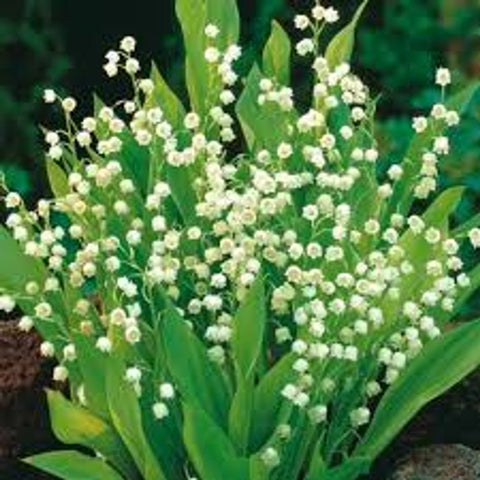

Lily of the Valley Plant - Convallaria majalis
Lily of the Valley is a native flowering perennial with petite white blooms. The scientific name is Convallaria majalis, a member of the Asparagaceae family. The plant has long been prized for its fragrant white bell-shaped flowers bloom in the early spring and have a sweet, almost lemony scent.
The flowers, typically about two inches long, grow on top of a short stem surrounded by two long, narrow, pointed leaves. The plant is also known for its bright green, heart-shaped leaves, which are highly ornamental.
Why Buy Lily of The Valley Plant
The plant is a popular garden addition due to its attractive blooms, making it an excellent choice for anyone seeking to add a class to their outdoor area. Lily of the valley is also an easy-care plant that doesn't require much maintenance, and it's an ideal choice for busy gardeners with little time to devote to their gardens.
Lily of the valley is a perfect choice for gardeners looking to add fragrance to their gardens. The blooms emit a sweet, floral scent that can fill an entire garden. In addition to its pleasant aroma, the plant is also known for its medicinal properties. It has been used in old medicine to treat various ailments, including heart disease, gout, and arthritis.
Lily of the valley is a low-maintenance plant that's easy to care for. It prefers partial shady locations but can tolerate full sun if necessary. It does best in moist, well-drained soil and will thrive in various soil types. It requires very little fertilizer and can be pruned back in the winter to keep it looking tidy.
Where Lily of The Valley Plant Grows Best?
The Lilly of the valley plant is best grown from partial to full shade and prefers moist and slightly acidic soils. Good drainage is also essential. The location should be damp but not wet, as the Lilly of the valley is not tolerant of standing water. When planting, use well-drained soil and amend it with compost or manure to improve fertility and drainage.
The Lilly of the valley will thrive in areas with cool temperatures, and it does not tolerate hot, dry climates. It is hardy in USDA zones 3-9, so it is suitable for most temperate gardens.
This plant does not need much maintenance, but it does benefit from an occasional trim back of the foliage in the spring. This will help to keep the plant tidy and promote better blooming. To propagate the Lily of the valley, divide the clumps in the spring or collect the seed pods and plant them in the fall.
HOW TO PLANT LILY OF THE VALLEY?
Before planting, prepare the soil by adding compost or other organic fertilizer to improve drainage and fertility. The soil should be at least 50% compost, and the pH should be between 5.5 and 6.5.
Next, purchase some lilies of the valley plants from a garden center. Plant the plants in a shady spot, spacing them about 8-10 inches apart. Dig a shallow hole, just deep enough to cover the plant's roots. Place the plant in the hole, backfill it with soil, and gently tamp it down. Water the plants thoroughly.
Once planted, it spreads quickly and can even become invasive, so it's essential to keep the plants in check by removing dead or dying flowers, leaves, and stems.
BUY LILY OF THE VALLEY ONLINE AT NANCE PLANTS.
The Lilly of the valley needs regular watering and may need to be divided every two or three years. To divide, dig up the roots and separate the roots into smaller sections. Replant the sections in the same spot or another spot if desired.
FAQ
1. When is the best time to plant Lily of the Valley?
A. The best time to plant lily of the valley (Convallaria majalis) is in the early fall or late spring. Both of these seasons provide favorable conditions for the establishment of the plants
2. Does Lily of the valley spread?
A. Yes, lily of the valley (Convallaria majalis) is known for its spreading habit. This plant spreads through underground rhizomes, which are horizontal stems that grow beneath the soil surface.
Finally, enjoy the beautiful, fragrant blooms of your Lily of the valley plants! You can enjoy these plants for many years with a bit of care.
One Year Guarantee on all Perennials & Ferns. See Healthy Plant Guarantee for more details.
Color:
White
Ships As:
Root/Rhizome
Season:
Late Spring, Summer
Zone:
3-9
Exposure:
Partial - Full Shade
Deer Resistant:
Yes
Native:
No




